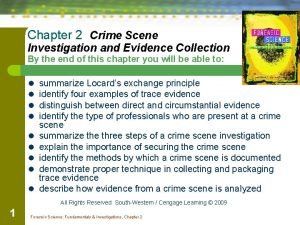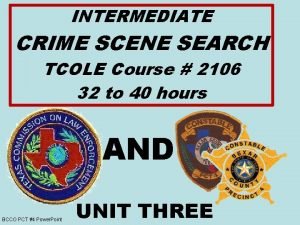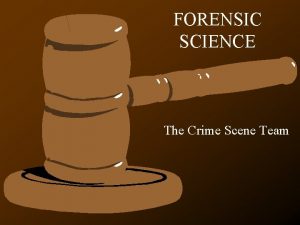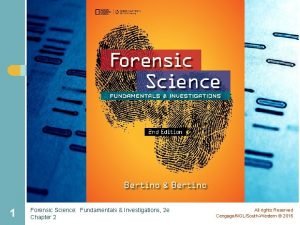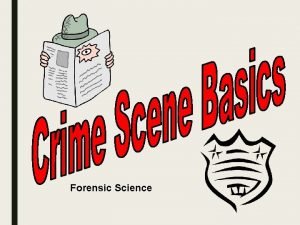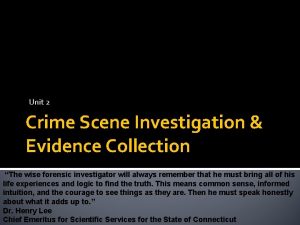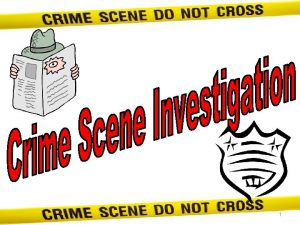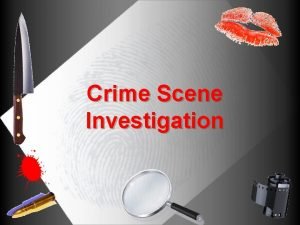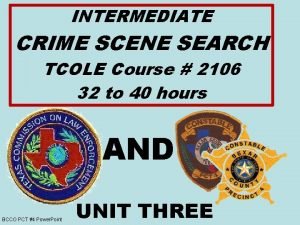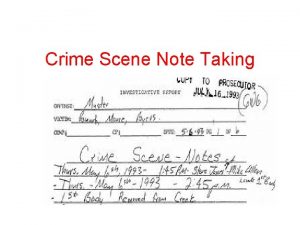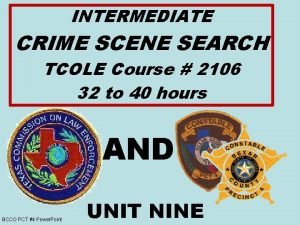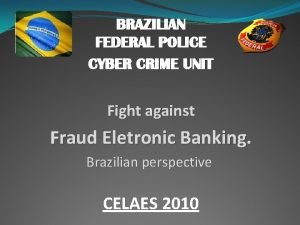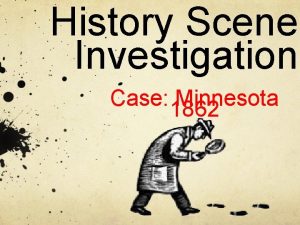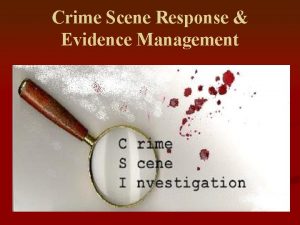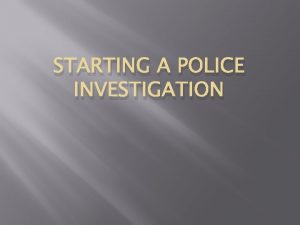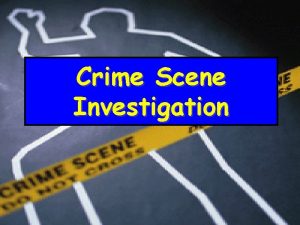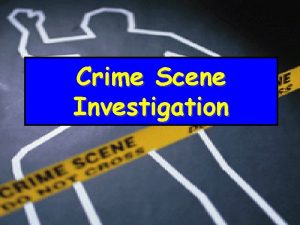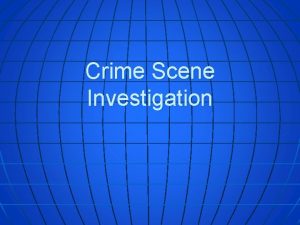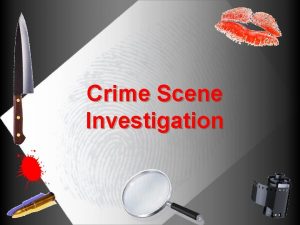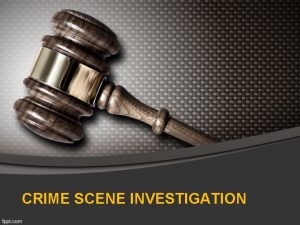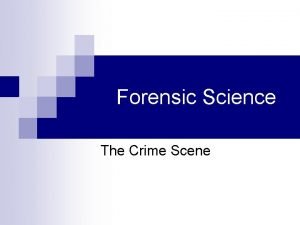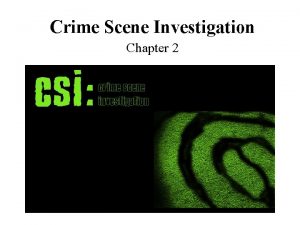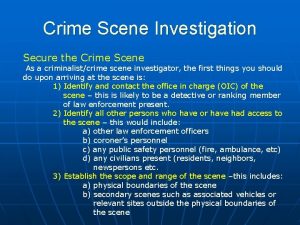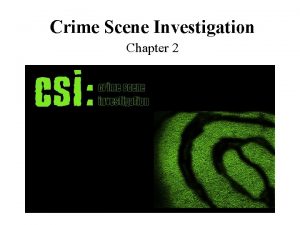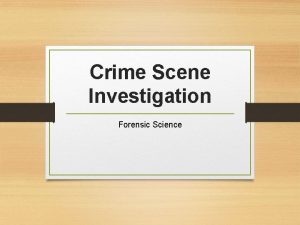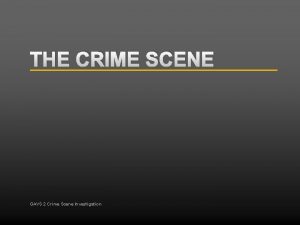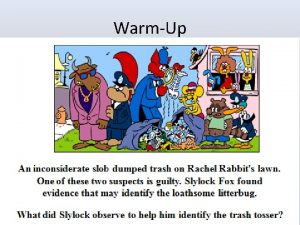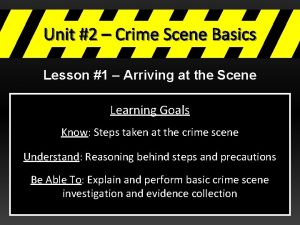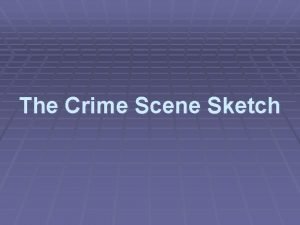STARTING A POLICE INVESTIGATION The Crime Scene Arriving





















- Slides: 21

STARTING A POLICE INVESTIGATION

The “Crime Scene” � Arriving at a “Crime Scene”— the location where an offense takes place is referred to as the crime scene.

What to do first? � � When officers arrive they have three tasks to perform: Assist injured people/call an ambulance Call in reinforcements to eliminate hazards (bombs, fires etc. ) Continue to search the crime scene—even if they think perpetrators have left. ASSUME PERPETRATORS ARE PRESENT AND ARMED.

Protecting and Preserving the Crime Scene —success in prosecuting a case often depends on the evidence collected. Officers must establish two boundaries— the centre (where the offense was committed) and the perimeter (surrounding areas where evidence may be present)

� Crime scenes are preserved for three reasons: allow for search, seize and collect evidence and ensure evidence is not contaminated (loss, destruction or alteration of physical evidence)

Officers at the Crime Scene � Officers role at a crime scene—Four types of officers investigate at a crime: Scenes of Crime Officer Criminal Identification Officer Criminal Investigations Bureau Officer Patrol Officer

Scenes of Crime Officer—trained in evidence collection/preservation Criminal Identification Officer— resp. for searching the crime scene for evidence

Criminal Investigations Bureau Officer—detective with experience in specific area (homicide, robbery, sexual offences) Patrol Officer—usually first on the scene. Must secure crime scene/arrest suspects.

Physical Evidence � � � Collection, preservation and analysis of evidence is crucial Physical evidence is defined as: any object, impression or body element that can be used to prove or disprove facts relating to an offense Valuable because it often carried greater weight in court than witness statements

Forensic Science � � � The use of biochemical and other scientific techniques to analyze evidence in a criminal investigation Work done mostly in the lab but experts also testify in court Examples: autopsy, firearms/ballistics, forensic chemists, etc

Tools � � � The tools used in the commission of a crime leave an imprint behind May have individual characteristics Most common: hammer, screwdriver, crowbar

Impressions � � 1. 2. Patterns or marks found on surfaces and caused by various objects Fingers, gloves, shoes, tires, tools etc Impression recorded by photographing/scanning it or taking a mould Two characteristics: Class characteristics: general attributes Individual characteristics: specific to that object

Fingerprints � � � Patterned marks left by a fingertip (also hands, feet, toes) Unique and never change Visible fingerprint: print formed in blood, grease or some other substance—seen by the naked eye Latent fingerprint—formed by natural oils and perspiration. Invisible to the naked eye Fingerprints can sometimes be left INSIDE gloves

Shoe prints � � � Can be matched to suspect Best if they have four prints—two of each foot Can determine height, weight, injuries, whether the suspect was carrying anything, walking or running

Tires tracks Can determine the make of tire � make of car (sometimes) � the direction the car was travelling when it entered/left the crime scene �

Body elements and DNA � � � Crimes often result in the transfer of bodily fluids Blood, semen, mucus, sputum, hair, skin Sent for laboratory analysis Analyzed for a match to the suspect Hair and fibres may also be matched

Chain of custody � � � Proper labelling is important Who has contact with the evidence The date and time the evidence was handled The circumstances under which the evidence was handled What changes, if any, were made to the evidence

Information required: � � � � Brief description Police case number Date collected Location of collection Brand name of item (if any) Serial number Name and badge number of officer who collected Destination for storage or analysis

Forensics Presentation Fingerprinting Impressions (imprints) Tire/car tracks Anthropology Poisons Tool impressions Bodily Fluids Hair Analysis Forensic Dentistry Facial recognition software Ballistics Blood Autopsy DNA


Marking � � � � Creativity. Group Dynamics Organization Presentation Skills Class mark Activity Case discussed Total -50 Students will have 3 days to complete the task. - Due on Monday October 31 st, 2016.
 Locard exchange principle
Locard exchange principle Tcole 2106 crime scene investigation
Tcole 2106 crime scene investigation The seven s's of crime scene investigation
The seven s's of crime scene investigation Crime scence investigator
Crime scence investigator Subdatum points
Subdatum points Semen collection bags
Semen collection bags Crime scene investigation background
Crime scene investigation background Seven s's of crime scene investigation description
Seven s's of crime scene investigation description Intermediate crime scene investigation texas
Intermediate crime scene investigation texas The term encompasses all objects
The term encompasses all objects What are the 5 steps in crime scene investigation
What are the 5 steps in crime scene investigation 2106 crime scene investigation
2106 crime scene investigation Note taking crime scene investigation
Note taking crime scene investigation 2106 crime scene investigation
2106 crime scene investigation Welcoming and greeting the guest procedure
Welcoming and greeting the guest procedure Stippling
Stippling Federal police cyber crime
Federal police cyber crime History scene investigation
History scene investigation Historical scene investigation
Historical scene investigation Crime scene storyboard
Crime scene storyboard Crime scene factoring and quadratic functions answer key
Crime scene factoring and quadratic functions answer key Crime scene
Crime scene
